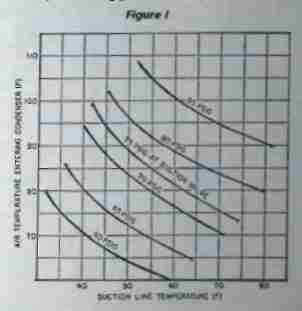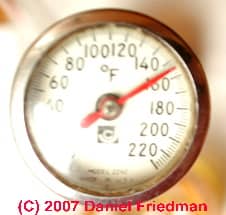 Air Conditioning & Heat Pump Temperature Q&A
Air Conditioning & Heat Pump Temperature Q&A
Set 2 of HVAC Temperature FAQs
- POST a QUESTION or COMMENT about air conditioning or heat pump system temperatures,
HVAC system temperature FAQs #2:
More Q&A on air conditioner or heat pump system temperatures at the equipment, at the cooling or heating coil, at the supply or return registers, & how those temperatures help diagnose HVAC system problems.
What are the the normal or abnormal operating temperatures of air conditioning equipment when measured at different locations.
InspectAPedia tolerates no conflicts of interest. We have no relationship with advertisers, products, or services discussed at this website.
- Daniel Friedman, Publisher/Editor/Author - See WHO ARE WE?
Air Conditioning / Heat Pump Temperatures Diagnostic Questions & Answers
 Air conditioner temperatures that are too high or too low can indicate
specific operating problems on central and portable or window air conditioners. These questions & answers about air conditioner or heat pump operating temperatures were posted originally
Air conditioner temperatures that are too high or too low can indicate
specific operating problems on central and portable or window air conditioners. These questions & answers about air conditioner or heat pump operating temperatures were posted originally
at AIR CONDITIONER TEMPERATURES - the topic home - please be sure to review our more-complete A/C temperature adjustment, troubleshooting and repair steps given there.
Article Contents
- TEMPERATURE READING, ABNORMAL FAQs
- TEMPERATURE READING, NORMAL FAQs
- TEMPERATURE READING FAQs, OTHER
- COMPRESSOR CONDENSER TEMPERATURE & PRESSURE FAQs
- CONDENSER TEMPERATURE FAQs
- EVAPORATOR COIL TEMPERATURE FAQs
- ROOM TEMPERATURE VARIATION FAQs - indoor air temperatures
...
A/C & Heat Pump Compressor/Condenser Unit Temperature & Pressure FAQs
What temperatures are measured right at the compressor motor itself?
My home HVAC unit has a compressor temperature of 125 to 150 deg is that too hot? On 2018-07-05
by Ken
Reply by (mod) - is my A/C compressor too hot?
Probably not, but then you need to explain where and how your measuring the temperature.
Is the outside compressor unit controlled by indoor temperature?
Is the outside compressor controlled by the temperature outdoors? At a outdoor temp. of 72F and the indoor temp around the same and I turn the thermostate to 70F the compressor will not run only the fan.
When the outdoor temp is 82F or higher the compressor runs normally. - Compressor situation
Reply:
The outside compressor on a residential cooling system basically runs under control of the thermostat that is calling for cooling.
So it's the indoor temperature that is going to turn the outside compressor/condenser unit on and off as needed.
But both the efficiency of the system and indirectly its operating temperature will be affected by outdoor air temperature.
In hotter outdoor air the compressor/condenser has to work harder, and perhaps longer to condense the refirgerant back to a liquid.
...
A/C System vs Room Temperature Difference FAQs
Carrier AC Temperature Differential of 14.6- OK?
Just bought a newly constructed home. Measured temp differential in a number of rooms after the hvac system had been running for a couple of hours.
Best reading we got was a differential of 14.6 degrees. Isn't that kind of ow for a brand new Carrier HVAC system? - On 2017-09-27 by arny -
Reply by (mod) - Reply:
Measured as air temperature entering and leaving the cooling coil in an air conditioning system, we expect to see 15-20 degrees F.
14.6 degF is so close to that that I'd not consider it a problem.
What is the maximum that an air conditioner can cool indoor air below outdoor air ?
I think I remember maybe that I might have read somewhere that a home central air conditiorne has a difficult time holding an inside air temperature more than 20 degrees F below the outside temperature. True or False? - Dennis 7/6/11
Reply: it depends...
Dennis: my OPINION, though we don't care for "true or false" questions, is that the answer is ... it depends. On a newly installed split system I was working with last week the unit had no trouble getting indoor temp down to 68 F when it was 90 F outside.
But building insulation, heat loss or gain rates, solar gain, air leaks, etc. all add up to having an enormous effect on just what a given heating or cooling system can attain.
What is the minimum temperature for central air conditioning?
what is the minimum temperature for central air conditioning system? - Sibaji 9/27/11
Reply:
Sibaji
The output temp of a central air conditioning system depends on the temperature of the air entering the cooling system.Typically we see about a 15 to 23 deg F temp drop across the cooling coil inside the air handler. Length and insulation of and on ductwork will mean the temp you measure at a cool air supply register will be somewhat warmer.
Compare outdoor, indoor and air handler output temperatures
We replaced our 9 year old central air unit with a new one (both 4 tons) and also added another air return. The new unit does not cool as well as the old unit.
The outside temp is about 100 degrees.
The air output temp is 67 degrees.
The house stays at 82 degrees.
Any idea why the new unit is not doing at least as good a job as the old? - John Hazel 8/5/11
Reply: things to check
I think you're saying that despite an output air temperature of 67 degF at the supply registers, your home is not cooling below 82 degF when its 100 degF outside.
You need a more expert onsite diagnosis than I can guess from just the information below, John, but I'd start by looking at
- air flow at the supply registers
- temperature drop across the cooling coil (look for 15-20 degF as typical)
- the blower fan cleanliness and fan speed
- obstructions in the ductwork - including a dirty or obstructing air filter or crimped or disconnected ductwork
...
Compressor Condenser Unit Temperature FAQs
Is 180 degF air out at the condenser unit too hot?
The air blowing out of the outside compressor / condenser is 180 degrees is that too high? On 2017-05-11 by Ray Nickel
Reply by (mod) no
Ray:
Typically we measure the air temperature drop across the cooling coil in the air handler: Delta-T or temperature drop across the coil, as per the article above on this page, reports that a typical temperature drop is 15 to 20 deg .F.
Keep in mind that the temperature in the cooled space as well as air flow rates and coil clogging by dust and debris (or frost) will significantly affect this temperature reading.For example a much higher temperature drop across the cooling coil might indicate a dirt or ice blocked coil, a dirty air handler blower fan, dirty filter, reduced air flow for other reasons (crimped ductwork) or on occasion low refrigerant due to a leak.
Measuring temperature across the outdoor compressor/condenser unit is less useful as an indicator of the A/C condition because of the very wide range of outdoor temperatures.
Because the compressor is condensing low pressure refrigerant gas to a high pressure temperature also rises, often to well over 100 degrees F. and temperatures from 180 degF. to 200 degF are normal.
In fact if the high pressure refrigerant gas were not hotter than outdoor air the air blowing across the outdoor condensing coil wouldn't be accepting heat from the coil.
...
Evaporator Coil Temperature FAQs
What's the Normal Temperature variation along the A-Coil (evaporator coil) between inlet end and outlet end
In a 4-ton home air conditioning system, using a hand-help non-contact thermometer, I find a great temperature variation along the A-coil from refrigerant input side to refrigerant discharge side
6 degF at the inlet,
62 degF at the outlet
Is this a normal variation over the extent of the A-coil? (Jerry Whelan whelanjh@gmail.com ) On 2015-09-05 by whelanjh -
Reply by (mod) Typical temperature drop is 15 to 20 deg.F across the evaporator coil at the indoor air handler
Jerry
I don't think you're making or reporting temperature measurements correctly.
You would not see 6 degreesF at an A/C coil inlet - that's well below freezing and well below normal operating temperatures.
At A/C school we were taught to bring the frost line to the coil outlet, figuring that at that point we're evaporating all of the refrigerant being metered into the coil.
If the coil is quite warm at the outlet it sounds as if either the system is nearly out of refrigerant or the metering device ins not properly adjusted.
...
Continue reading at AIR CONDITIONER TEMPERATURES - normal, abnormal, rules of thumb, simple diagnostics - topic home, or select a topic from the closely-related articles below, or see the complete ARTICLE INDEX.
Or see these
Recommended Articles
Suggested citation for this web page
AIR CONDITIONER TEMPERATURE FAQs-2 at InspectApedia.com - online encyclopedia of building & environmental inspection, testing, diagnosis, repair, & problem prevention advice.
Or see this
INDEX to RELATED ARTICLES: ARTICLE INDEX to AIR CONDITIONING & HEAT PUMPS
Or use the SEARCH BOX found below to Ask a Question or Search InspectApedia
Ask a Question or Search InspectApedia
Try the search box just below, or if you prefer, post a question or comment in the Comments box below and we will respond promptly.
Search the InspectApedia website
Note: appearance of your Comment below may be delayed: if your comment contains an image, photograph, web link, or text that looks to the software as if it might be a web link, your posting will appear after it has been approved by a moderator. Apologies for the delay.
Only one image can be added per comment but you can post as many comments, and therefore images, as you like.
You will not receive a notification when a response to your question has been posted.
Please bookmark this page to make it easy for you to check back for our response.
IF above you see "Comment Form is loading comments..." then COMMENT BOX - countable.ca / bawkbox.com IS NOT WORKING.
In any case you are welcome to send an email directly to us at InspectApedia.com at editor@inspectApedia.com
We'll reply to you directly. Please help us help you by noting, in your email, the URL of the InspectApedia page where you wanted to comment.
Citations & References
In addition to any citations in the article above, a full list is available on request.
- In addition to citations & references found in this article, see the research citations given at the end of the related articles found at our suggested
CONTINUE READING or RECOMMENDED ARTICLES.
- Carson, Dunlop & Associates Ltd., 120 Carlton Street Suite 407, Toronto ON M5A 4K2. Tel: (416) 964-9415 1-800-268-7070 Email: info@carsondunlop.com. Alan Carson is a past president of ASHI, the American Society of Home Inspectors.
Thanks to Alan Carson and Bob Dunlop, for permission for InspectAPedia to use text excerpts from The HOME REFERENCE BOOK - the Encyclopedia of Homes and to use illustrations from The ILLUSTRATED HOME .
Carson Dunlop Associates provides extensive home inspection education and report writing material. In gratitude we provide links to tsome Carson Dunlop Associates products and services.

